However, you will find that the app lacks a feature for how to delete Cash App history, as transaction records are permanent. Clicking on a payment reveals only its specific details and completion status. Moreover, selecting the three dots at the top-right corner of a transaction gives you two options: either to obtain a digital receipt or to contact support for any concerns.
Navigating Cash App’s Activity Tab
Cash App’s user-friendly interface includes an Activity tab, accessible by tapping the clock icon in the bottom-right corner of the app. This tab is a comprehensive record of all past transactions, providing detailed information about each one, including its current status (completed or pending).
Is It Possible to Delete Cash App History?
One of the most common questions among Cash App users is whether they can delete or hide their transaction history. The answer is no. Cash App, like many other digital payment services, does not offer the option to delete transaction records. This approach is not just a design choice but a requirement for regulatory compliance and accurate financial record-keeping.
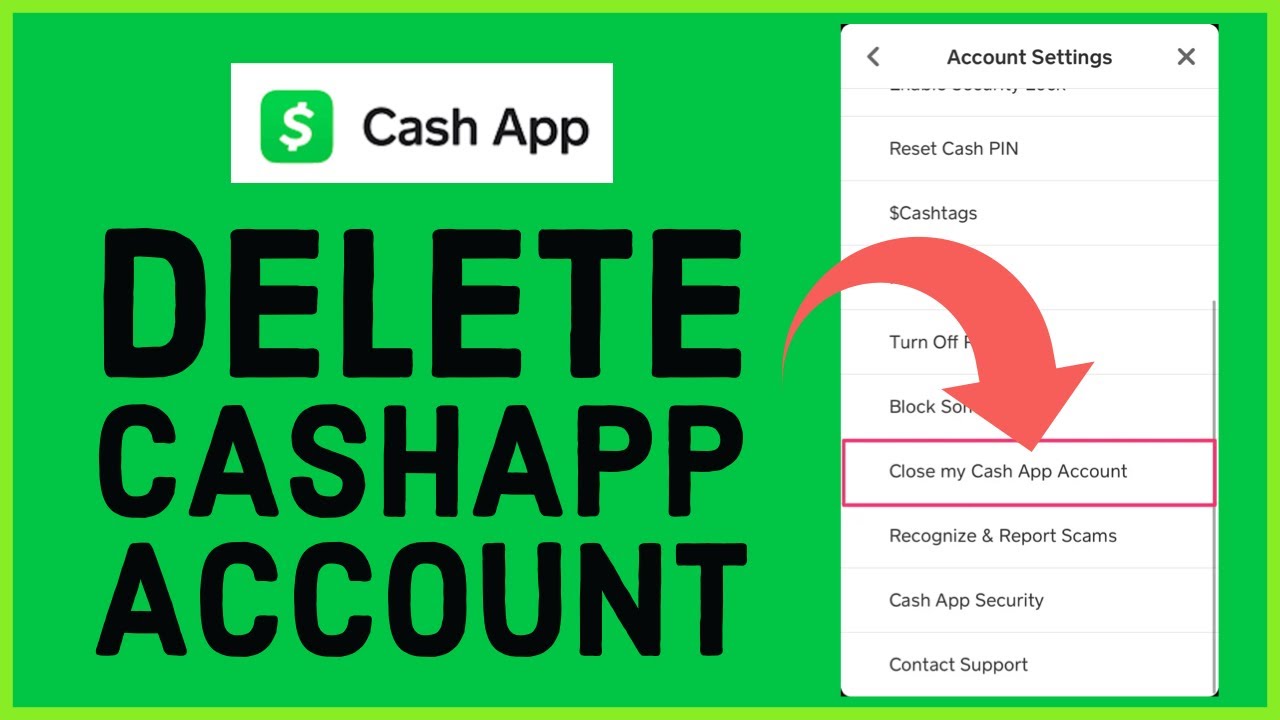
Cash App does not provide a feature to delete or alter the transaction history within its application. This limitation is often a topic of interest among users who are concerned about their privacy or simply wish to manage their digital financial records. Here’s a more detailed look into this aspect of Cash App:
Why Can’t You Delete Cash App History?
- Regulatory Compliance: Financial institutions, including digital payment platforms like Cash App, are required to comply with various financial regulations. These regulations often mandate the retention of transaction records for a certain period to prevent fraud, money laundering, and other illicit activities.
- Financial Record Keeping: Transaction histories serve as important financial records for users. They can be crucial for personal budgeting, resolving disputes, and tax purposes. Maintaining an immutable record of transactions helps in ensuring accuracy and reliability in financial dealings.
- Security Considerations: Permanent transaction histories can also serve as a security feature. They allow users and the service provider to monitor for unauthorized transactions or discrepancies in accounts, which can be an early indicator of security breaches or fraud.
What Options Do Users Have?
- Privacy by Default: Cash App already ensures that all transactions are private. Only the parties involved in the transaction can view its details. This design choice negates the need for additional privacy settings for each transaction.
- Contacting Support: If there’s a specific issue with a transaction, users can contact Cash App support. While this won’t delete the transaction, it can help resolve problems or provide clarity on particular transactions.
- Account Deactivation: The extreme step for those who want to erase their transaction history is to deactivate their Cash App account. However, this is a drastic measure as it leads to the loss of access to the app and its services.
The Bottom Line
While the inability to delete transaction history on Cash App might seem like a limitation, it is a common practice among digital financial services. This approach is largely driven by the need to comply with legal and regulatory standards, maintain accurate financial records, and ensure security. Users concerned about privacy should find solace in the fact that their transactions are private and visible only to the parties involved. For those seeking to eliminate their digital footprint entirely, deactivating the account remains the only, albeit significant, option.
Privacy in Cash App Transactions
Cash App stands out from other services such as Venmo by ensuring that all transactions are private by default. Only the parties involved in a transaction have access to its details. This feature highlights Cash App’s commitment to user privacy, making additional privacy settings for individual transactions unnecessary.
Deactivating Your Cash App Account
For users who are determined to remove their transaction history, the only method available is to deactivate their Cash App account. However, it’s important to note that this action is irreversible and results in the loss of access to all features and services of the app.
Deactivating Your Cash App Account: A Last Resort for Transaction History Removal
Removing transaction history from Cash App, the only definitive option available to users is to deactivate their Cash App account. This action, while extreme, is the only method to effectively remove all traces of your transaction history from the app. However, it’s crucial to understand the implications and permanence of this decision.
Understanding the Irreversibility
When you decide to deactivate your Cash App account, it’s not just a temporary suspension—it’s a complete termination of your association with the app. This action is irreversible, meaning once you’ve deactivated your account, it cannot be reinstated. All your transaction records, along with your account details, are permanently deleted.
Loss of Access to Features and Services
Deactivation leads to the loss of access to all the features and services offered by Cash App. This includes:
- Sending and Receiving Money: You will no longer be able to send or receive money through Cash App.
- Access to Cash Card: If you have a Cash Card associated with your account, it will be deactivated.
- Investments and Bitcoin Transactions: Any investments or Bitcoin holdings you have in the app will become inaccessible.
- Stored Funds: Any remaining balance in your Cash App account will need to be withdrawn or transferred out before deactivation, as you’ll lose access to these funds.
Steps to Deactivate Your Account
To deactivate your Cash App account, you’ll need to take the following steps:
- Transfer or Withdraw Funds: Ensure all your funds are transferred out of your Cash App account.
- Download Transaction History: If you need a record of your transactions, make sure to download them before deactivation.
- Contact Support: Reach out to Cash App support to initiate the deactivation process. They may require verification to ensure that the request is legitimate.
Considerations Before Deactivation
Before you proceed with account deactivation, consider the following:
- Necessity: Evaluate if deactivating your account is absolutely necessary, as you’ll lose a convenient means of digital transactions.
- Impact on Financial Management: Consider how this will affect your financial management, especially if you regularly use Cash App for transactions.
- Alternative Options: Explore if there are other ways to address your concerns regarding transaction history without resorting to account deactivation.
Ensuring Security in Cash App
While it’s not possible to delete Cash App history, users can fortify their account security. Creating robust, distinct passwords and enabling two-factor authentication is advisable. Moreover, it’s important to monitor who has physical access to your device to prevent unauthorized views of your Cash App history.
Cash App provides a convenient platform for digital transactions, but like all financial services, it requires users to be vigilant about security. Ensuring the security of your Cash App account is crucial to protect your financial information and prevent unauthorized access or fraud. Here’s a detailed guide on how you can maximize security within Cash App:
Strong and Unique Passwords
- Use Complex Passwords: Your Cash App account’s first line of defense is a strong password. Use a combination of letters (both uppercase and lowercase), numbers, and symbols.
- Avoid Common Passwords: Stay away from easily guessable passwords like “123456” or “password.”
- Unique Passwords for Different Services: Do not reuse passwords across different sites and apps. If one service is compromised, others could be at risk.
Two-factor authentication (2FA)
- Enable 2FA: Cash App offers two-factor authentication, adding an extra layer of security. With 2FA, a code is sent to your phone or email, which you must enter to access your account.
- Update Contact Information: Ensure that your contact information is up to date so that you can receive 2FA codes without issue.
Regular Monitoring of Account Activity
- Check Your Activity Tab: Regularly review your transaction history in the Activity tab for any unfamiliar transactions.
- Prompt Reporting: If you notice any unauthorized activity, report it immediately to Cash App support.
Secure Internet Connections
- Avoid Public Wi-Fi: Refrain from using public Wi-Fi networks for financial transactions, as they are often not secure.
- Use Secure Networks: Conduct transactions over a secure, private internet connection.
Beware of Phishing Scams
- Recognize Phishing Attempts: Be cautious of emails or messages asking for your Cash App details or directing you to a login page.
- Verify Sources: Always verify the legitimacy of any communication claiming to be from Cash App.
Keeping the App Updated
- Regular Updates: Keep your Cash App updated to the latest version. Updates often include security patches and new features to enhance security.
Account Privacy Settings
- Review Privacy Settings: Regularly review your account settings to ensure they align with your privacy preferences.
Educate Yourself About Cash App Features
- Understand Cash App’s Functionality: Familiarize yourself with how Cash App works, including its security features and limitations.
Cryptocurrency on Cash App
As the digital currency landscape continues to evolve, Cash App remains at the forefront by offering users the ability to engage with cryptocurrency, notably Bitcoin. While Bitcoin is the primary cryptocurrency available for users to purchase, sell, and hold within the app, the anticipation surrounding the potential for diversification cannot be ignored, especially with the upcoming 2024-2025 bull run.
For those looking ahead, the “Top 5 Altcoins to Watch 2024-2025 Bull Run” presents an intriguing prospect. This forward-looking analysis could provide valuable insights for Cash App users who are exploring beyond Bitcoin and considering altcoin investments during the predicted bull market.
As market dynamics shift and user demand increases, platforms like Cash App may expand their cryptocurrency offerings. Staying informed about these changes is crucial for users looking to capitalize on the next wave of crypto trends. Whether Cash App will include more cryptocurrencies remains to be seen, but the potential for altcoin inclusion could align well with user interest in the digital assets poised for significant growth in the 2024-2025 bull run.
Keep an eye on Cash App’s updates, as they may align with the surging interest in altcoins, offering a gateway to the diverse crypto market right from your mobile device.
Conclusion
Cash App’s policy of not allowing users to delete transaction histories aligns with standard practices in digital financial services. This policy ensures transparency and compliance with legal standards. Although some users may find this inconvenient, the app’s design prioritizes privacy, with transactions visible only to the involved parties. For those who wish to completely erase their transaction history, account deactivation remains the only option, albeit with significant consequences.
]]>In today’s digital era, YouTube stands as a colossus in the content creation universe, a platform where creativity meets opportunity. However, as the platform grows exponentially, content creators face the challenge of staying relevant and efficient amidst fierce competition. This is where YouTube Automation, a groundbreaking approach to streamlining video content strategy, comes into play.
YouTube Automation is more than just a buzzword; it’s a transformative strategy that empowers creators to maximize their efficiency and effectiveness on the platform. By automating various aspects of the YouTube content creation process, from SEO optimization and scheduling to community engagement and performance tracking, creators can focus more on the creative aspects of their work while ensuring their channel’s growth and sustainability.
This guide delves deep into the world of YouTube Automation, providing you with insights, tools, and tactics to harness the power of automation. Whether you’re a seasoned YouTuber or just starting, understanding and implementing these strategies can dramatically change the way you approach content creation. We’ll explore various aspects of YouTube Automation, including content planning, SEO, analytics, and community management, and provide practical tips and tools to help you automate these processes effectively.
Join us as we unravel the secrets of YouTube Automation, offering you a comprehensive roadmap to elevate your YouTube channel to new heights of success and efficiency. Let’s embark on this journey of discovery and transformation, unlocking the full potential of your YouTube channel with the power of automation.

1. Understanding YouTube Automation
Delve into the essentials of automating your YouTube channel to enhance productivity and content quality.
- What is YouTube Automation? It’s about leveraging tools and technology to manage repetitive tasks like content scheduling, SEO optimization, and analytics monitoring, making content creation more efficient.
- Benefits: Emphasize how automation saves valuable time, ensures consistency in content delivery, and enhances the overall quality and reach of your videos.
2. Choosing the Right Tools and Software
Selecting appropriate automation tools is key to streamlining your YouTube channel management.
- Popular Tools: Explore tools like TubeBuddy, VidIQ, and Hootsuite for various automation needs.
- Tool Comparison: Assess each tool for its specific features, usability, and how it aligns with your channel’s requirements and goals.
3. Automating Content Creation
Streamline your content creation process with smart automation techniques and tools.
- Batch Production: Create videos in batches to maintain a consistent posting schedule, using Canva for designing thumbnails and templates to ensure a uniform look across your videos.
- Template Use: Leverage templates for video scripting, thumbnails, and graphics to maintain a cohesive and professional appearance.
4. Automating YouTube SEO
Optimize your video reach with automated SEO strategies.
- Keyword Research Tools: Utilize tools like Google Keyword Planner and Ahrefs to find high-ranking keywords.
- SEO Automation: Implement techniques to automate the optimization of titles, descriptions, and tags, enhancing your video’s searchability and visibility.
5. Streamlining Scheduling and Uploading
Efficient scheduling and uploading can significantly boost your channel’s performance.
- Scheduling Tools: Utilize YouTube’s in-built scheduler or third-party apps for timely uploads, ensuring your content reaches your audience when they are most active.
- Optimal Timing: Determine the best times for posting your content to maximize engagement and viewership.
6. Automating Community Engagement
Build and maintain an engaged community with automated tools.
- Comment Moderation Tools: Use automation for managing comments and engaging with your audience, while keeping the conversation healthy and constructive.
- Engagement Tips: Set up personalized automated responses to frequently asked questions and general comments to foster a sense of community.
7. Leveraging Analytics and Performance Tracking
Make informed decisions based on data to enhance your channel’s performance.
- Analytic Tools: Use tools like YouTube Analytics and Social Blade for comprehensive insights into your channel’s performance.
- Data-Driven Strategies: Analyze this data to refine your content strategy, optimize your posting schedule, and identify successful content types.
8. Ethical Considerations and Best Practices
Ensure ethical use of automation tools while maintaining genuine audience engagement.
- Authentic Engagement: Balance automation with authentic interaction to keep your audience engaged and loyal.
- Ethical Use of Tools: Be mindful of avoiding practices that might come across as inauthentic or spam-like.
9. Learning from Successful Case Studies
Draw inspiration and lessons from successful YouTubers who effectively use automation.
- Real-World Examples: Analyze the strategies of successful channels that have incorporated automation effectively.
- Lessons Learned: Apply these insights to your own channel, adapting their successful tactics to your unique content and audience.
Conclusion: Weighing the Pros and Cons of YouTube Automation
In the evolving landscape of YouTube content creation, automation emerges as a double-edged sword, offering both significant benefits and potential pitfalls. On one hand, YouTube Automation represents a powerful tool for content creators, enabling them to save time, increase efficiency, ensure consistency, and leverage data analysis for strategic decisions. By automating tasks such as video uploading, content scheduling, and audience communication, creators can reallocate their efforts towards crafting high-quality content that resonates with their audience.
However, it’s crucial to navigate the realm of automation with caution. The risks associated with YouTube Automation, such as the potential for account suspension due to non-compliance with YouTube’s guidelines, cannot be overlooked. Automated interactions often lack the authenticity of human connection, potentially leading to low-quality engagement that may seem spammy or insincere to viewers. This lack of personalization can diminish the value of creator-audience interactions, crucial in building a loyal community. Furthermore, the inflexibility of some automation tools may limit creative freedom, posing challenges in content diversification and experimentation.
As content creators on YouTube, it’s essential to strike a balance. While embracing the efficiency and consistency offered by automation, maintaining a personal, authentic touch in your content and interactions is vital. Use automation as a tool to enhance your channel’s operational aspects but keep the core of your content and community engagement genuinely human.
In conclusion, YouTube Automation is an invaluable asset in a creator’s toolkit, but it should be used judiciously. By carefully considering its advantages and drawbacks, creators can effectively utilize automation to augment their channel’s success while preserving the authenticity that truly connects with their audience.
Utilizing a YouTube Thumbnail Downloader is a game-changer for content creators looking to elevate their video presentation. This tool allows you to download and analyze thumbnails from popular videos within your niche, offering a wealth of insight into successful design trends. By studying these thumbnails, you can discern what combinations of styles, colors, and fonts are most appealing to viewers, thereby informing your own thumbnail creation. This practice is crucial for ensuring that your videos not only attract attention but also resonate with your target audience amidst a sea of content. To delve deeper into maximizing the potential of a YouTube Thumbnail Downloader, explore our in-depth guide here.
]]>For Instagram creators, the view count on reels is an important metric. It gives insights into the performance and reach of their content. When this count isn’t visible, it could be due to several reasons. An outdated Instagram app is a common culprit. It’s essential to ensure that the app is updated to the latest version. Another possibility is that the reel’s creator has chosen to hide the views count. Lastly, it could be a technical glitch within the app itself.

How to Fix Instagram Reels Views Count: Step-by-Step Guide
- Update the Instagram App: Start by updating your Instagram app. This can be done through your device’s app store. Keeping the app updated ensures you have the latest features and bug fixes.
- Check Professional Dashboard for Creators: If you’re a creator, go to your profile and tap on the “Professional dashboard”. Here, click on “Insights” and then select the reel whose views count you want to check.
- Directly View Insights from Content Page: Another method for creators is to check the views count directly from the content page. Scroll down to the reels icon on your profile page, select a reel, and tap on “View Insights” to see the view count, along with other engagement metrics.
- Viewer’s Method to See Views Count: For viewers, to see the views count on someone else’s reel, tap below the heart or like button on the reel. If the count is not visible, the creator might have chosen to hide it.
- Troubleshoot Internet Connection Issues: If you’re facing issues across multiple reels, check your internet connection. Switch to a different data network or Wi-Fi connection to see if it resolves the issue.
- Regularly Update the App: Lastly, regularly updating your Instagram app is crucial. It helps avoid technical glitches and ensures access to the latest features.
In some instances, none of these steps might work. This could be due to a more significant technical issue within the app. Regularly updating the Instagram app is crucial as it helps avoid such glitches and ensures you have access to the latest features and fixes.
Instagram also gives users the option to manage the visibility of views and likes on their reels and posts. This feature can be found under the privacy settings of the app. Users can toggle off the switch in front of “Hide Views and likes” if they prefer to keep their engagement metrics private.
Common Technical Issues Faced by Instagram Users and Solutions
Instagram, with its vast user base, is not immune to technical glitches. Users often encounter various issues that can hinder their social media experience. Here are some of the most common technical problems faced by Instagram users, along with their solutions:
- Instagram Crashing or Not Opening: This is a frequent issue where the app crashes upon opening or doesn’t open at all. To resolve this, first, try restarting your phone. If the problem persists, check for app updates in the app store or consider reinstalling the app.
- Problems with Uploading Photos or Videos: Sometimes, users find difficulty in uploading media to their feed or stories. This can often be due to a weak internet connection. Ensure you have a strong and stable connection. If the problem continues, check if the file format of your media is supported by Instagram.
- Issues with Instagram Stories: Issues like stories not uploading, disappearing too quickly, or filters not working are common. These can usually be fixed by updating the app, as Instagram frequently releases updates to fix such bugs.
- Direct Message (DM) Issues: Problems with sending or receiving messages can be frustrating. To fix this, try logging out and back into your account. If the issue remains, check your internet connection, or the Instagram server status online.
- Account Login Problems: Sometimes users are unable to log into their accounts. This could be due to forgotten passwords or a technical glitch. Attempt to reset your password first. If this doesn’t work, seek help from Instagram’s support center.
- Feed Not Refreshing: If your feed isn’t updating with new content, start by checking your internet connection. You can also try clearing the app’s cache (for Android users) or reinstalling the app.
- Notification Issues: If you’re not receiving notifications, check if you’ve accidentally turned them off in the app’s settings or your phone’s notification settings. Ensure that the app is updated to the latest version as well.
- Problems with Instagram Live: Issues like the live feature not working or crashing can occur. These can be due to unstable internet connections, outdated app versions, or glitches in your device’s operating system. Ensure all aspects are updated and stable.
- Difficulty in Tagging or Mentioning Users: This can happen if the tagged account has privacy settings that restrict tagging or if there’s a glitch in the app. Ensure the app is updated, and if the problem is privacy-related, contact the user directly.
- Commenting Issues: Sometimes, comments may not post, disappear, or the commenting feature might be completely inaccessible. This can be due to network issues, account restrictions, or app bugs. Check your connection, app version, and account settings.
In summary, many Instagram issues can be resolved by basic troubleshooting like updating the app, checking your internet connection, or clearing cache. For persistent problems, contacting Instagram support is recommended. Remember, regular app updates and maintaining a stable internet connection can prevent many of these issues.
In conclusion, while encountering issues with Instagram Reels views count can be frustrating, there are several easy fixes that both creators and viewers can employ. By staying informed and taking proactive steps, you can ensure a seamless and enjoyable experience on one of the world’s most popular social media platforms.
Encountering issues with previewing YouTube Shorts can be a stumbling block for content creators and viewers alike. This concise guide will provide you with an easy 6-step process to troubleshoot and resolve the ‘Unable to Preview YouTube Shorts‘ issue, ensuring a seamless viewing and sharing experience.
]]>Understanding the Unable to Preview Youtube Shorts Error on YouTube Shorts
When you’re busy creating content for YouTube Shorts, encountering any error can be a setback, especially something like the “Unable to Preview YouTube Shorts” error. Typically, YouTube facilitates creators by displaying a preview of the short video before it goes live. This preview feature is pivotal for creators to perform final reviews and ensure everything in the video appears as intended — from the video quality to the inclusion of key elements like subtitles, graphics, or special effects.

Effective Strategies to Fix the “Unable to Preview” Issue on YouTube Shorts:
- Alternative Video Editing Software:
- Challenge: Creators using DaVinci Resolve or similar high-end editing tools often face the “Unable to Preview” error.
- Solution: Switching to a different video editor can circumvent these issues. This error can stem from high bitrates, complex video codecs, or resolution compatibility issues inherent in professional-grade software.
- Suggestion: Simpler editors like Adobe Premiere Rush, iMovie, or even YouTube’s built-in editor may be less prone to these complications. The key is finding a balance between quality and compatibility.
- Modify the Short with a Different App:
- Rationale: Small edits or format changes can refresh the file’s metadata, potentially resolving preview issues.
- Action: Use accessible editing apps (like Canva or InShot) to add subtle text overlays, stickers, or even a quick trim. These apps are not only user-friendly but also frequently updated to align with social media platforms’ specifications.
- Benefit: This method can help you circumvent issues tied to the original file format or encoding, smoothing out the upload process.
- Quality Adjustment:
- Problem: Videos exceeding 2K resolution might be overkill for Shorts and can trigger preview errors.
- Solution: Reducing the video quality to 1080p or lower can often fix the preview issue. Remember, YouTube Shorts is more about content accessibility and less about ultra-high definition.
- Consideration: While quality is important, platform-specific optimization is key for a smoother user experience and wider reach.
- Utilizing Desktop for Uploads:
- Context: Mobile apps, while convenient, might have bugs or glitches that desktop versions don’t.
- Method: Log into your YouTube account via a web browser on your desktop or laptop and try uploading your Short.
- Advantage: Desktop interfaces often offer more stability and detailed feedback during the upload process, helping to identify and fix any issues.
- Clear YouTube App Cache and Update:
- Why It Works: Clearing cache removes old and potentially corrupt data that can cause app issues, while updating ensures you have the latest features and bug fixes.
- Steps: Go to your device’s Settings, find YouTube under Apps, and clear both cache and data. Then, head to your app store and update YouTube to the latest version.
- Note: Clearing data might log you out, so ensure you know your login details.
- Stable Internet Connection:
- Issue: A shaky internet connection can interrupt video uploads and lead to various errors, including preview issues.
- Solution: Connect to a stable, fast Wi-Fi network before attempting your upload.
- Tip: If you’re unsure about your connection’s stability, tools like Speedtest by Ookla can help you assess your upload speeds before you begin. Additionally, using Fast.com for a quick internet speed check is another effective way to evaluate your connection’s readiness for uploading large files like YouTube Shorts. Fast.com, provided by Netflix, offers a user-friendly interface and immediate feedback on your internet speed, ensuring you’re equipped for a smooth upload experience.
Encountering the “Unable to Preview YouTube Shorts” error can be frustrating, but it’s usually a quick fix. Often, this issue is related to video format compatibility or application glitches. To fix the Unable to Preview YouTube Shorts problem, try converting your video into a format supported by YouTube Shorts, or check for any updates on your YouTube app. These simple steps can swiftly restore your ability to preview and upload your content seamlessly
Enhancing Your YouTube Strategy: The Role of Thumbnails
While addressing technical issues like the “Unable to Preview” error is crucial, another key aspect of your YouTube strategy should include the visual appeal of your content — particularly, your video thumbnails. A compelling thumbnail can significantly impact your video’s click-through rate and overall success. This is where a YouTube Thumbnail Downloader comes into play.
Utilizing a YouTube Thumbnail Downloader allows creators to analyze and draw inspiration from successful thumbnails in their niche. By examining the thumbnails of trending or popular videos, you can gain insights into what styles, colors, and fonts capture the audience’s attention. It’s an invaluable tool for refining your thumbnail strategy, ensuring your videos stand out in a crowded feed. For more detailed insights and tips on using a thumbnail downloader effectively, check out our comprehensive guide here.
Remember, a thumbnail is often the first impression viewers have of your video. Make it count!

Conclusion
Navigating the “Unable to Preview” error on YouTube Shorts doesn’t have to be a daunting task. By addressing potential issues through various practical solutions – from switching editing software to ensuring a stable internet connection – creators can effectively minimize disruptions in their content upload process. While each strategy varies in its approach, the common goal is to ensure that your creative content is seen and enjoyed by your audience without technical hindrances.
Remember, the digital world is ever-evolving, and so are its challenges. Staying adaptable, informed, and proactive in troubleshooting can significantly enhance your content creation and sharing experience. With these tips and techniques, you’re well-equipped to continue delivering compelling, high-quality Shorts that captivate and grow your audience on YouTube.
]]>The Rise of the Discontented Worker
Over the decades, societal norms have heavily ingrained the idea that success equates to a stable job, a steady income, and climbing the corporate ladder. However, with increasing cases of burnout, mental health challenges, and the evident disconnect between personal passions and professional roles, many are questioning this age-old paradigm. What if there’s more to life than just working?
However, in recent times, cracks have begun to show in this well-trodden path. The modern workplace, with its demands for constant connectivity, long hours, and frequent sacrifices of personal time, has given rise to alarming rates of burnout. More people are feeling overworked, undervalued, and stretched to their limits. This, coupled with the growing awareness and understanding of mental health, has shed light on the negative repercussions of relentless professional grind on one’s psychological well-being.
Furthermore, the once clear demarcation between professional and personal life is blurring. Individuals are yearning for jobs that not only pay the bills but also align with their passions, values, and long-term life goals. The realization that a significant portion of one’s life is spent at work has prompted many to ask: Shouldn’t this time be spent doing something fulfilling, meaningful, and aligned with one’s true self?
This rising discontent is also fueled by the digital age, where stories of people pursuing alternative careers, living life on their own terms, and finding success outside the 9-to-5 framework are rampant. Such narratives challenge the conventional wisdom and inspire others to question the status quo.
In essence, a growing segment of the workforce is confronting a profound existential question: Is the traditional model of work still relevant? Is the sacrifice of personal well-being and passions worth the supposed stability and societal approval? Or is there a way to redefine success, prioritizing happiness, fulfillment, and mental health alongside professional growth?

Reimagining Success: What Does It Look Like?
Success is subjective, and its definition varies from one individual to another. For some, it may involve financial independence achieved through passive income sources. For others, it might be pursuing passions, traveling the world, or even simply enjoying the day-to-day without the weight of obligations. The key is to introspect and define what success truly means to you.
In today’s ever-changing world, traditional markers of success are constantly being re-evaluated and redefined. Success is no longer just about material achievements or societal approval. It has evolved to reflect personal values, experiences, and aspirations.
The beauty of success is its inherent subjectivity. What one person views as a pinnacle of achievement might be entirely different for another. For instance, while some people equate success with financial independence—perhaps secured through streams of passive income—others might find their true calling and satisfaction in chasing their passions, traveling to unexplored destinations, or relishing the simple joys of daily life without feeling burdened by endless responsibilities.
It’s crucial, in this context, to engage in deep introspection. By understanding what truly resonates with you, what ignites your passion, and where your values lie, you can carve out your own definition of success. It’s not about fitting into societal molds but rather about forging a path that aligns with your individual goals and desires. So, as you navigate your personal and professional journey, take a moment to ask yourself: What does success truly mean to me?
Alternative Lifestyles: Exploring Different Paths
In an age where societal norms and traditional life trajectories are increasingly being questioned, many individuals are seeking alternatives that align more closely with their personal values and aspirations. The notion of a one-size-fits-all approach to life — comprising of a stable job, a fixed residence, and a predictable routine — no longer resonates with a significant portion of the global populace. Instead, there’s a burgeoning interest in lifestyles that offer flexibility, purpose, and a break from conventionality.
From the digital wanderlust of nomads who fuse work with travel, to the simplicity enthusiasts decluttering their lives, from the ambitious self-starters turning passions into paychecks, to the altruistic souls finding meaning in service, a variety of alternative lifestyles are emerging as pathways to personal fulfillment. Let’s dive deeper into these intriguing avenues: Digital Nomadism, Minimalistic Living, Entrepreneurship, and Volunteerism, and explore the unique promises and challenges each presents.
- Digital Nomadism: Embracing remote work and leveraging technology to work from anywhere, be it the beaches of Bali or the mountains of Switzerland.
- Minimalistic Living: Simplifying one’s life, reducing possessions, and living with less, often resulting in decreased financial burdens and increased freedom.
- Entrepreneurship: Transforming passions into businesses, allowing individuals to do what they love while potentially earning a living.
- Volunteerism: Dedicating time and skills to causes, which can offer purpose and fulfillment, albeit potentially without a traditional paycheck.
Challenges and Considerations
While it’s tempting to dream of a life free from a traditional job, it’s essential to approach this shift with pragmatism. There are real challenges, such as financial security, societal judgments, and the unpredictability of non-traditional paths. It’s vital to plan, prepare, and educate oneself before making significant changes.
First Steps Towards Crafting Your Ideal Life
- Self-reflection: Understand your passions, skills, and what truly drives you.
- Research: Learn about different lifestyles and what they entail.
- Financial Planning: Create a safety net, explore passive income options, and understand your financial needs.
- Trial Periods: Test the waters by taking short breaks, working remotely, or starting side hustles.
- Seek Guidance: Join communities, find mentors, and surround yourself with like-minded individuals to support and guide your journey.
How to Find Your Best Fit Work?
Navigating the vast landscape of career opportunities can often feel like finding a needle in a haystack. However, discovering that perfect job or role that aligns with your skills, passions, and values is paramount to achieving both professional success and personal satisfaction. So, how do you pinpoint that perfect fit? Here’s a guide to help you on your journey:
- Self-Assessment: Before diving into the job market, take a moment to reflect. Understand your strengths, weaknesses, passions, and the environments in which you thrive. Tools like the Myers-Briggs Type Indicator or StrengthsFinder can offer insights into your personality and aptitudes.
- Define Your Values: Know what you stand for. Do you prioritize work-life balance? Is social impact crucial for you? By understanding what values are important, you can align yourself with companies and roles that resonate with those values.
- Research and Networking: Dive deep into industries or companies of interest. Connect with professionals in those fields through platforms like LinkedIn or alumni networks. Gather insights about the roles, the culture, and the day-to-day expectations.
- Test the Waters: If feasible, take on internships, short-term projects, or even volunteering roles in your areas of interest. These experiences can give you a real-world feel of the job and help you decide if it’s the right fit.
- Continuous Learning: Stay updated with industry trends, required skills, and emerging roles. Platforms like Coursera, Udemy, and Khan Academy offer courses on a plethora of subjects, helping you to acquire new skills or refine existing ones.
- Seek Feedback: Talk to mentors, peers, or professionals in your network. Their feedback can offer invaluable insights, shedding light on aspects you might not have considered.
- Trust Your Instincts: While logic, research, and advice are essential, don’t underestimate the power of your gut feeling. If a role or company feels right or wrong, trust that intuition.
- Embrace Flexibility: Understand that the ‘perfect fit’ today might change as you evolve personally and professionally. Be open to pivoting and adapting as you gain more experiences and insights into what you truly want from your career.
Remember, finding the best fit isn’t just about landing a job. It’s about discovering a role where you can grow, contribute, and find fulfillment. Take your time, be patient with the process, and trust that with due diligence and introspection, you’ll find your ideal professional path.
Conclusion: Embracing Authenticity in Life Choices
In a world that often equates worth with work, choosing to live differently can be daunting. However, by understanding one’s desires and taking informed steps, it’s possible to craft a life that prioritizes happiness and fulfillment over traditional employment. It’s a journey of self-discovery, bravery, and resilience, but at its core, it’s about living authentically.
The quest for meaning and purpose in life transcends the confines of traditional employment. “I Don’t Want a Job, I Just Want a Life” serves as a powerful reminder that success isn’t solely about a paycheck or a position on the corporate ladder. Instead, it’s about crafting a life rich in experiences, passions, and genuine happiness. As we navigate this ever-evolving world, let us not lose sight of what truly matters and have the courage to redefine success on our own terms. After all, a fulfilling life is the ultimate achievement.
Best Excuse to Quit a Job Without Notice
There comes a time in everyone’s professional journey when moving on from a current job is the best step forward. However, sometimes circumstances demand an immediate departure, and quitting without giving the traditional two-week notice becomes a reality. But how do you navigate this delicate situation gracefully? The answer lies in having a legitimate and compelling reason for your decision.
In the comprehensive guide available at HelpTricks, you’ll find a detailed 65-point breakdown of potential reasons that could serve as your justification for such a sudden exit. These reasons range from personal health concerns to unavoidable family emergencies and from unforeseen opportunities to matters of personal well-being.
]]>But what constitutes a “best” excuse? Ideally, it should be a reason that is both genuine and immediately pressing, such that waiting out a typical notice period could cause significant personal, professional, or emotional harm. This article aims to delve deep into this topic, offering readers a curated list of 65 best excuses to quit a job without notice. We’ll explore a spectrum of situations, from personal crises to professional roadblocks, ensuring that whatever your reason might be, you’ll find guidance and validation here. So, if you’re contemplating such a move, or simply wish to be prepared should life throw an unexpected curveball, read on.
Article Highlights: Best Excuse to Quit a Job Without Notice
- General Reasons for Departing
- Exiting a Newly Joined Job
- Opting Out Early from a Position
- Leaving Without Giving Notice

General Reasons for Departing
- HEALTH ISSUES: One of the most genuine excuses for quitting a job centers around health issues. When one’s profession begins to negatively affect their physical or mental well-being, it’s crucial to reassess priorities. No job is worth compromising health for, and most employers should understand and respect this decision when communicated sincerely.
- FAMILY CIRCUMSTANCES: Family emergencies or caregiving responsibilities can offer valid excuses for leaving a position. Such personal commitments can be unpredictable and demanding, making it challenging to juggle both work and family needs. Employers typically show empathy for such situations, as they recognize the importance of family.
- BETTER JOB OPPORTUNITY: Landing a more enticing job offer can serve as a strong excuse for departing. Whether it’s the allure of better pay, promising growth prospects, or superior benefits, receiving an offer too good to refuse is something many understand. Gratitude and transparency with the current employer can smooth this transition.
- CAREER CHANGE: Realizing that one’s current profession isn’t aligning with their broader career aspirations is a valid excuse for job departure. Over time, personal and professional interests can evolve, making a career pivot necessary. Articulating this shift in goals and aspirations is essential when discussing the reason for quitting.
- WORK-LIFE BALANCE: The quest for a healthier work-life balance is among the top excuses many give when leaving a job. An all-consuming job that leaves no space for personal life can be draining. As people increasingly prioritize personal time and well-being, employers should be receptive to this reason.
- PURSUING HIGHER EDUCATION: Choosing to further one’s education offers a solid excuse for job departure. Whether it’s chasing a higher degree or acquiring a specialized certification, educational aspirations are generally well-respected. Being upfront about these educational goals often garners support and understanding from employers.
- TRAVEL AND EXPLORATION: An innate desire to explore the world can provide a compelling excuse for quitting a job. Whether driven by personal growth or pure wanderlust, such decisions are often rooted in profound self-reflection. Keeping employers informed about these exploration plans can create a space for understanding and appreciation.
- COMPANY RESTRUCTURING OR MERGERS: Organizational changes, like mergers or restructuring, can lead to job insecurities. Such corporate shifts can serve as valid excuses to consider other job avenues, especially if one feels their role might be jeopardized or altered significantly.
- LACK OF JOB SATISFACTION: A diminishing sense of job satisfaction can justify seeking new opportunities. As one of the more subjective excuses, it’s rooted in personal feelings and motivations. Openly discussing these feelings with the employer can shed light on the underlying reasons for quitting.
- DISAGREEMENTS WITH MANAGEMENT: Constant conflicts with superiors can make staying in a job untenable. This excuse, while sensitive, resonates with many who’ve experienced difficult workplace dynamics. Navigating this reason requires tact and professionalism to avoid burning bridges.
- LACK OF ADVANCEMENT OPPORTUNITIES: Hitting a professional plateau can serve as an excuse to seek greener pastures. If growth and advancement within a company seem stagnant, it’s natural to consider other venues where one’s career can thrive.
- PURSUING A LONG-LOST DREAM: Rekindling a long-held passion or dream is a heartening excuse for quitting. Whether it’s penning a book or launching a startup, following one’s passion can lead to personal fulfillment. Sharing this journey with the employer can foster understanding and support.
- VOLUNTEERING ABROAD: Deciding to contribute globally by volunteering abroad is both unique and commendable. As an excuse, it reflects a deep commitment to societal betterment. Discussing these altruistic goals with employers can evoke respect and admiration.
- ACCEPTING A RARE OPPORTUNITY: Grabbing a once-in-a-lifetime opportunity is a compelling excuse to leave a job. Such chances, be it working under an industry luminary or a unique professional stint, are rare and transformative. Transparency about the nature of these opportunities can lead to encouragement and good wishes from the current employer.
- TAKING A SABBATICAL: The need for an extended break or sabbatical is becoming a more accepted excuse in today’s work culture. It’s a time for rejuvenation, rediscovery, and reflection. Informing employers about this decision can lead to future opportunities upon return.
- JOINING A FAMILY BUSINESS: Opting to bolster a family enterprise can serve as a heartfelt excuse to quit a current job. It showcases dedication to familial ties and a desire to uphold family legacy. Being open about this transition can foster a sense of respect and understanding from the employer.
- Cultural Mismatch: One of the more nuanced excuses for quitting a job centers around a cultural mismatch. An employee may find that the values, beliefs, and behaviors celebrated within a company starkly contrast their own personal ethos. This disconnect can often make daily interactions and longer-term goals feel out of alignment. When there’s a fundamental clash in values, it might indicate that the individual would thrive better in a different environment.
- Entrepreneurial Pursuits: An exciting and commendable reason to leave a position is to embark on entrepreneurial ventures. Launching a startup or establishing a business demands significant time, energy, and focus. When someone feels the call to be their own boss and chase after a business dream, it can become imperative to leave a regular job. This excuse showcases ambition, vision, and a drive to create something of one’s own.
- Job Role Mismatch: It’s not uncommon for employees to find themselves in roles that diverge from the initial job description. This kind of mismatch can lead to dissatisfaction, underutilization of skills, and feelings of deception. When the daily tasks and responsibilities don’t align with what was originally pitched, it’s a legitimate excuse to seek opportunities that better match one’s expertise and expectations.
- Contract End: For those who are in temporary or project-based roles, the natural conclusion of their contract is a straightforward reason for departure. Such positions have an inherent end date, making the transition expected. It’s a clear-cut excuse that doesn’t necessitate further explanations, given the temporary nature of the role from the outset.
- Retirement: One of the most definitive excuses for quitting a job is the transition to retirement. After dedicating years, if not decades, to the workforce, individuals earn the right to step back, relax, and enjoy the fruits of their labor. Retirement is a celebratory phase, marking the culmination of one’s professional journey and the beginning of a more leisurely pace of life.
These reasons provide legitimate and often relatable excuses for those seeking to explain their decision to leave a position, whether for personal growth, aligning with values, or transitioning to new life phases.
Exiting a Newly Joined Job
- Misrepresented Responsibilities: A common dilemma that new employees face is the stark contrast between what was pitched to them during interviews and the actual role they find themselves in. When the day-to-day tasks and overarching responsibilities don’t match the initial job description, it can lead to feelings of betrayal and disillusionment. This is a valid excuse for anyone seeking to leave a position soon after joining, as it indicates a misalignment right from the outset.
- Toxic Atmosphere: An unhealthy work environment can be debilitating. It’s not just about interpersonal conflicts; a toxic atmosphere can encompass a range of issues from systemic bullying to a lack of respect for work-life balance. When an employee finds themselves immersed in negative or harmful workplace dynamics soon after joining, it becomes imperative for their mental and emotional well-being to consider an exit.
- Lack of Resources: Every role has its demands, and for an employee to meet these demands, they require the right tools, training, and resources. If a new employee finds themselves constantly struggling due to the company’s lack of support or inadequate resources, it can hinder their performance and job satisfaction. Exiting under such circumstances can be attributed to the organization’s inability to provide the necessary groundwork for success.
- Dishonesty: Trust forms the bedrock of any professional relationship. Discovering deceptive practices, unethical behavior, or a lack of transparency in a company can be a jarring experience, especially for someone new. This is a serious concern and provides a strong excuse for someone to leave a job shortly after joining. Integrity matters, and if an organization lacks it, employees may rightfully question their association.
- Poor Fit: Sometimes, it’s not about the role, the resources, or the environment; it’s a gut feeling. An individual might realize quickly that the company’s culture, values, or even the pace of work doesn’t resonate with their personal or professional aspirations. Recognizing a poor fit early on and taking steps to exit can save both the employee and the employer prolonged dissatisfaction and potential conflicts.
Exiting a newly joined job can be a daunting decision, but when there are clear indicators that the association won’t be beneficial in the long run, it’s a step that might need consideration. The above reasons shed light on some of the most common challenges new employees face in such situations.
Opting Out Early from a Position
- Relocation Needs: Sometimes, personal or familial circumstances necessitate moving to a different city or even a different country. It’s often challenging to juggle a job while dealing with such a significant change, making relocation one of the most genuine excuses to leave a position early.
- Personal Development: An individual’s journey of self-improvement and personal growth might require them to take a sabbatical from their job. Be it pursuing higher education, taking a course, or diving deep into personal projects, when self-growth calls, it might mean opting out of a position temporarily or permanently.
- Life Changes: Major life events, such as the birth of a child, a marriage, or a health crisis, demand undivided attention. Such significant personal shifts might make it nearly impossible to maintain the same level of commitment to a job.
- Clash with Company Culture: A misalignment between an employee’s values and the company’s practices can lead to dissatisfaction and discomfort. When there’s a consistent clash with company culture, it might be a sign that the organization isn’t the right fit.
- Overburdening Workloads: While challenges are part of any job, excessive demands that affect mental and physical well-being are not sustainable. If an employee constantly feels overwhelmed without any respite in sight, it’s a valid excuse to reconsider their position.
- Conflicts with Team Members: A harmonious team environment is crucial for productivity. Continuous disagreements or conflicts with colleagues can disrupt workflow and affect job satisfaction, making it a legitimate reason to think about an exit.
- Company’s Financial Woes: Working in an organization that’s showing signs of financial instability can be unnerving. If there are clear indicators like regular delays in salary or a sudden freeze in hiring, it might be a precursor to layoffs or even a shutdown.
- Unfavorable Shifts or Hours: Unsustainable work timings, especially if they disrupt an individual’s work-life balance or health, can be taxing. If adjustments or negotiations don’t lead to a solution, leaving might be the only option.
- Lack of Mentoring: For many, especially those in the early stages of their career, guidance is invaluable. The absence of mentoring or support can stunt professional growth and lead to feelings of stagnation.
- Job Security Concerns: Anxiety about the future, fueled by rumors or evident signs of upcoming layoffs, can make an environment tense. Employees might prefer to opt-out early, taking a proactive approach to their career trajectory.
- Mismatched Skills: Discovering that a role isn’t playing to one’s strengths or expertise can be disheartening. If there’s a realization that the job doesn’t align with one’s skill set, it might be time to find a role that does.
Leaving a position early is never an easy decision, but understanding the underlying reasons can provide clarity. These points elucidate some of the common challenges individuals face when considering an early exit from their role.
Leaving Without Giving Notice
- Immediate Personal Crises: Life can be unpredictable. Urgent family matters or personal emergencies, such as the sudden illness of a loved one or a tragic accident, might necessitate immediate attention, leaving no room for the standard notice period.
- Safety Threats: No job is worth one’s safety. When an employee faces a direct threat or finds themselves in an unsafe work environment—whether it’s due to faulty infrastructure, unaddressed threats from colleagues, or any other immediate danger—leaving without notice can be a matter of personal security.
- Unbearable Conditions: Situations amounting to constructive dismissal, where the conditions become so intolerable that the employee feels forced to resign, often don’t allow the luxury of a notice period. In such instances, leaving might be the only way to protect one’s sanity and dignity.
- Immediate Health Emergencies: Health always comes first. A sudden health crisis, whether it’s a severe diagnosis or an unexpected medical emergency, might require an employee to leave their position immediately.
- Unexpected Relocation: Life circumstances, such as a spouse’s sudden job transfer or a family exigency, can lead to abrupt relocations. When there’s no time for prolonged farewells, leaving without notice becomes inevitable.
- Witnessing Illegal Activities: Coming across or being privy to unlawful actions in the workplace can put an employee in a precarious position. When the moral and ethical dilemma becomes too great, leaving without notice might be the best option.
- Mental Health Concerns: Mental well-being is as crucial as physical health. If the work environment or the nature of the job poses an immediate threat to one’s mental health, the employee might need to make a swift exit to prioritize their well-being.
- Unresolved Conflicts: Occasionally, conflicts at work can escalate rapidly without resolution. When differences become untenable, and there’s no hope for mediation, some might choose to leave without prolonging the agony.
- Harassment or Discrimination: An environment marred by prejudice, whether it’s due to race, gender, sexuality, or any other form of discrimination, is toxic. If such behaviors go unchecked and the victim feels trapped, leaving without notice becomes a step towards self-preservation.
- Breach of Contract: Trust is a two-way street. When employers fail to honor their contractual terms, whether it’s related to remuneration, work conditions, or any other agreed-upon clauses, employees might feel compelled to leave without adhering to notice requirements.
Leaving a job without notice is a significant step, often taken under pressing circumstances. While it’s not the norm and can come with professional repercussions, these reasons highlight scenarios where such a decision might feel like the only viable option.

Additional Considerations
- Continual Pay Issues: Financial stability is a significant motivator for most employees. Consistent problems with compensation, delayed salaries, or irregularities can be incredibly demotivating and might be a reason for looking elsewhere.
- Shift in Company Vision: When one’s personal ambitions and the company’s evolving direction diverge, it can lead to a sense of detachment and lack of fulfillment. If an organization’s new vision doesn’t resonate, it might be time to reconsider one’s place in it.
- Environment Issues: An uncomfortable or hazardous workspace can make daily tasks challenging. Poor infrastructure, unsafe conditions, or even a lack of necessary resources can be a big push factor for employees.
- Learning Stagnation: Growth is vital. When opportunities to upskill, learn, or take on new challenges diminish, employees might feel their career progression stalling.
- Unreasonable Expectations: Being continuously set up for failure by receiving unattainable tasks or unrealistic goals can be extremely stressful, pushing individuals to look for more reasonable work environments.
- Micro-management: The feeling of constantly being watched or second-guessed can erode job satisfaction. Lack of trust or freedom in executing tasks can suffocate creativity and motivation.
- Unethical Practices: Moral and ethical values are crucial. When a company’s actions starkly conflict with an individual’s ethical standards, it becomes challenging to continue association with them.
- Over-qualification: Sometimes, individuals might realize that they’re too qualified for the role they’re in, leading to feelings of underutilization or boredom.
- Redundancy: Engaging in monotonous, repetitive tasks can lead to decreased motivation, urging individuals to look for roles that offer variety and innovation.
- Mismatched Team Dynamics: A harmonious team is crucial for productivity. If an individual finds that their team’s dynamics don’t resonate with their work style, it can lead to friction and dissatisfaction.
- Benefits Reduction: Benefits and perks form part of an employee’s compensation package. When these are reduced without adequate justification, it can feel like a breach of trust.
- Lack of Flexibility: Today’s workforce often seeks flexibility in working hours, especially if personal circumstances demand it. Inflexible work schedules can be a major deterrent.
- Long Commute: A lengthy or difficult commute can add hours to a workday, impacting personal life and well-being. Over time, this can lead to burnout or the desire for a more conveniently located job.
- Change in Leadership: Leadership transitions can bring about shifts in company culture, priorities, or work dynamics. If these changes disrupt an individual’s work-life harmony, it might lead to reconsideration.
- No Challenge: Employees seek stimulating tasks. A role lacking challenges can become monotonous, leading to disengagement.
- Outside Commitments: At times, personal commitments or engagements outside work can impact job performance, making it challenging to maintain a work-life balance.
- Inadequate Feedback: Constructive feedback is vital for growth. When there’s ambiguity about performance or expectations, employees might feel lost or undervalued.
- Trust Issues: Trust is the bedrock of any professional relationship. Experiencing breaches of trust, be it with management or colleagues, can lead to a poisoned work environment.
In conclusion, while the reasons to quit a job are diverse, they often revolve around personal values, career aspirations, and workplace conditions. It’s essential to handle such decisions with tact and professionalism, ensuring open channels of communication to facilitate smooth transitions and maintain positive professional relationships.
In 2023, the professional landscape has seen remarkable shifts. The advent of hybrid workspaces means adaptability to both remote and on-site environments is prized. There’s a growing emphasis on soft skills like emotional intelligence and adaptability, alongside technical expertise. Moreover, in an age of rapid technological change, continuous learning is no longer optional but a necessity. As job seekers navigate this terrain, staying updated with the latest industry trends and skilling priorities is crucial to standing out in the competitive job market. Read more here.
Frequently Asked Questions before Quitting Jobs
What are some of the best excuses to quit a job without notice?
he piece delves into various reasons, from personal circumstances to specific workplace issues, that might prompt someone to leave a job without prior notice
How should I approach my employer if I need to quit without giving notice?
While each situation is unique, it’s always emphasized to approach such decisions with transparency, respect, and professionalism to ensure the best possible outcome.
Are all the reasons mentioned universally accepted for quitting without notice?
Not necessarily. While many reasons are provided, it’s essential to understand that their acceptability might vary based on the employer and the specific context.
What can I do to make the transition smoother after quitting abruptly?
Clear and honest communication with your employer is vital. Even if the reasons are compelling, striving for an amicable separation is always beneficial.

Let us now go through the unique features and attributes of the above-mentioned different computer malware types.
What is Computer Malware?
01. Computer Virus
A computer virus replicates itself with the support of other executable programs in the host machine. There are various ways that this type of malicious software could enter a computer. Some of the most common entry points are through a computer network, through external storage devices, and through email attachments. After entering the machine, it attaches itself with executable files in the host computer.
Thereafter the process of self-replication commences. This is how it spreads into other files or programs in the host machine, infecting them in-line. Once a computer virus enters the machine, it is always in the active state. That is due to its aforementioned attachment with executable files. A computer virus has the ability to damage the data, hardware and the software of the infected machine.
02. Computer Worms
Computer worms are somewhat similar to computer viruses, yet computer worms have some unique features. They have the ability to work on their own and spread on their own. The significance of computer worms is that they can duplicate themselves from one machine to another without attaching themselves onto them, unlike computer viruses. Email attachments and fake websites are some common entry points that computer worms use to invade computers.
03. Trojan Horse
One of the interesting points about this computer malware type is that a historic background lies behind this term ‘Trojan Horse’. It is based on how Greeks used a wooden horse as a tricky craft to deceitfully enter the city of Troy. This computer malware type acts the same. They always appear to be legitimate, and harmless. Hence, it deceives the users into loading and executing them on their devices. But once they are executed, they cause major harm to the host. So this behaviour depicts how good it matches the term ‘Trojan Horse’.
Once a trojan horse enters a machine, the machine might act weird in a number of ways. Automatically opening and closing windows, abrupt changes in the desktop, and disappearance of documents might be a few indications of a trojan horse attack. Apart from that, trojan horses are capable of stealing data and spying on the host. Of course, they distress the users in numerous ways.
04. Ransomware
Ransomware is one of the most popular computer malware types in the present world. Simply, it is a file-encrypting malware. Once ransomware enters a computer, it encrypts the user’s personal data in such a way that they cannot be recovered unless the user pays the attacker. The normal process is that the victim is shown instructions on how to make the payment to get the decryption key in return.
05. Adware
Adware is designed in order to display unwanted advertisements on a user’s screen. They might most probably appear as pop-ups, or rather as unclosable windows, within web browsers. Of course, they are not as harmful as computer viruses. Yet, they are still a form of malware that can become a hassle to the users.
06. Phishing
The basic concept behind phishing is misleading the user. Afterwards, hacking the information related to the user’s bank accounts and other online accounts will follow. In this case, the targeted user is most probably reached through an email or a text message. These messages are often sent posing as a legitimate organization, or a known person. Most of the time, along with these deceptive messages a link that appears to be important will also be sent. Once the user clicks this link, or fills and sends a seemingly real form, the user’s sensitive information will be stolen.
How to protect oneself from Computer Malware?
Now we have a clear idea on a few malware types, how they act, and what kind of impact they have on the host computers. Malware is still a serious threat. Therefore, let us now discuss how to protect our computer from these computer malware types.
- Install an Antivirus Software into your computer and keep it updated.
- Scan each and every external storage device that you connect to your computer, with the use of an updated Antivirus Software.
- Always use legitimate software.

If your computer is connected to the internet,
- Always enter into trusted websites.
- Use trusted websites to download software and other applications.
- Be conscious when opening email attachments. Do not click on suspicious links, and do not open suspicious emails and attachments.
- Use firewalls, virus guards, and email filters.
Related Importance of Cybersecurity in 2021
It is great if you know a couple of tie knots that can be used on different occasions rather than wearing the same thing every day. Here, we will be looking into some famous tie knots with a step-by-step guide and informative illustrations.
The most widely used tie knot is the simple knot or the oriental knot. Other than that, here are some other ways of tying your tie knot;
Types of Tie Knots
- Four In Hand Knot
- Half Windsor Knot
- Full Windsor Knot
- Nicky Knot
- Bow Tie Knot
- Kelvin Knot
- Pratt Knot
- St. Andrew Knot
- Balthus Knot
- Hanover Knot
- Plattsburgh Knot
- Grantchester Knot and etc.
Now, let’s look into five of those styles in detail. Of the types of tie knots first, the simplest of them all.
The Simple/Oriental Knot
Your tie should be draped around the collar, seam-inwards, thick end to the left and placed 2 / 3 inches lower than the finishing spot.
Then bring the thick end across the front of the narrow end and pass it back behind it, both horizontally.
Then pass it again across the front of the know from left to right and then behind the knot from right to left and then again in front of the knot. This time from left to right.
Put your finger under this loop.
Hold the tip of the think end, bring it up from behind the knot and put it under the third loop and pull it down. Now, you should be able to adjust it by holding the knot from one hand and pulling the narrow end gently.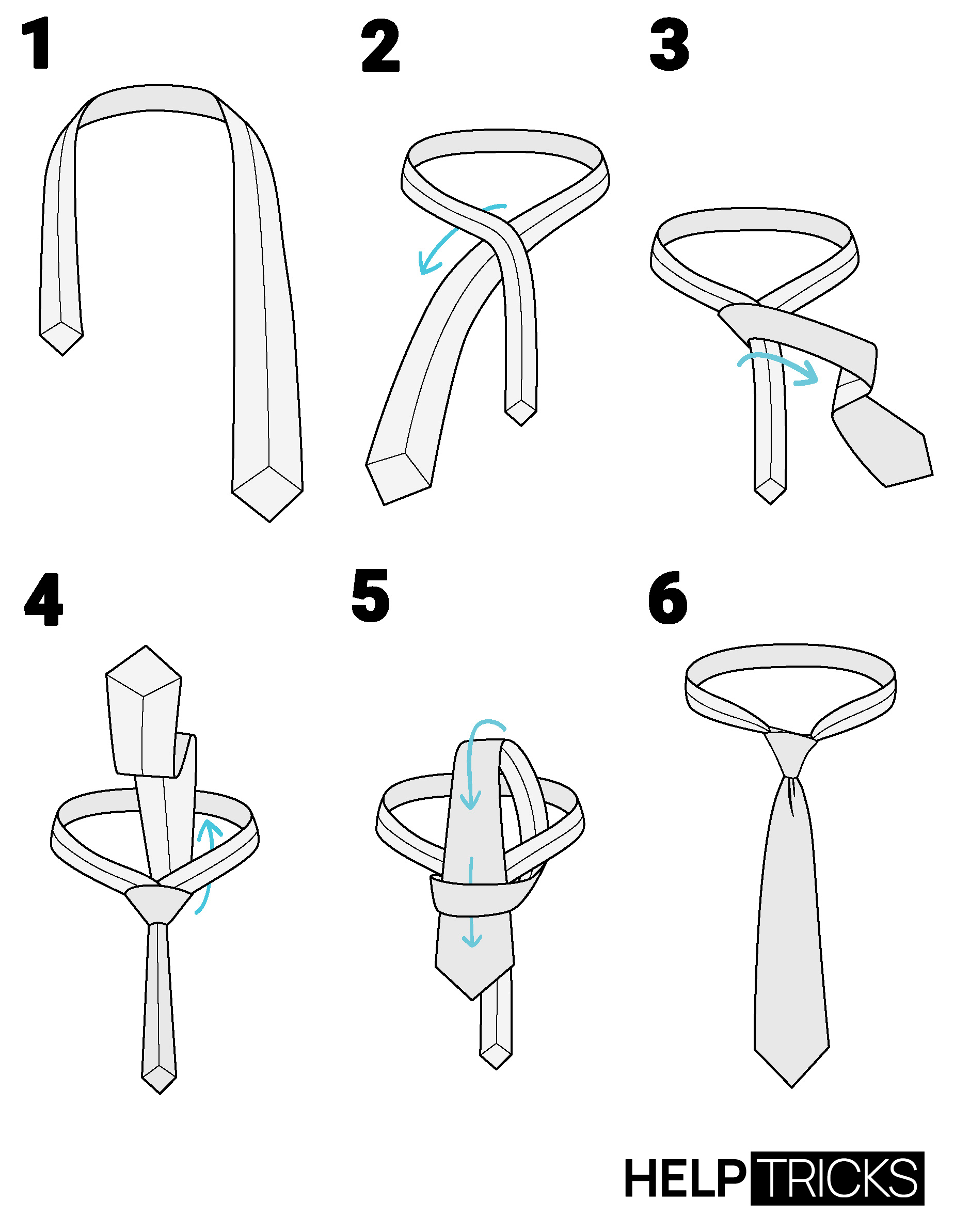
Four In Hand Knot
The first step is to wrap the tie around the collar, thick end to the left of yours hanging 3 / 4 inches lower than the narrow end. And cross the thick end in front of the narrow end.
Then put the thick end behind the narrow end and again put it behind horizontally from right to left and do it once more.
Put your finger behind the second horizontal band and turn the thick end upward and put it through the loop (which you’ve been holding with your finger). Pull the thick end enough to make a tight knot. You can do it by gently pulling on the narrow end.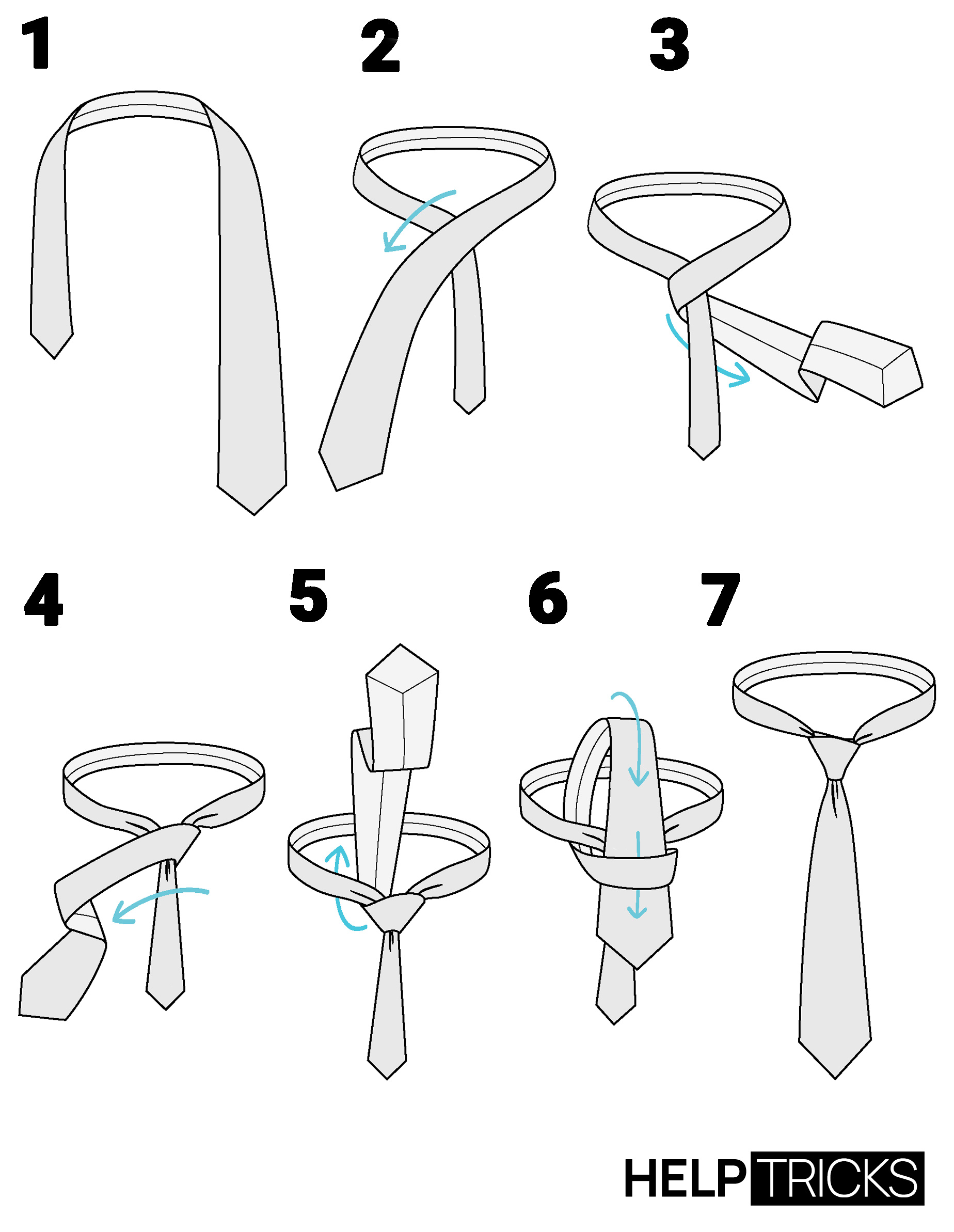
Full Windsor Knot
This is a bit tricky.
Drape the tie around the collar and leave the thick end hanging on the right beneath 4 / 6 inches down the waistband.
Cross the thick end horizontally in an ‘X’ shape in front of the narrow end.
Put the thick end up and take it out from the top and put it behind the narrow end again.
Put the thick end up in front of the knot and take it out from the left side and put it horizontally in front of the knot from left to right.
Place a finger on that loop and bring the thick end underneath that loop around the collar. The tip should face upwards.
Hold the thick end and bring it downwards through the loop you’ve been holding and make a knot. Smoothen the knot evenly with your hands and adjust it.
Full Windsor Knot or the Double Windsor requires rather a long tie than other knots and looks pretty neat on a suit.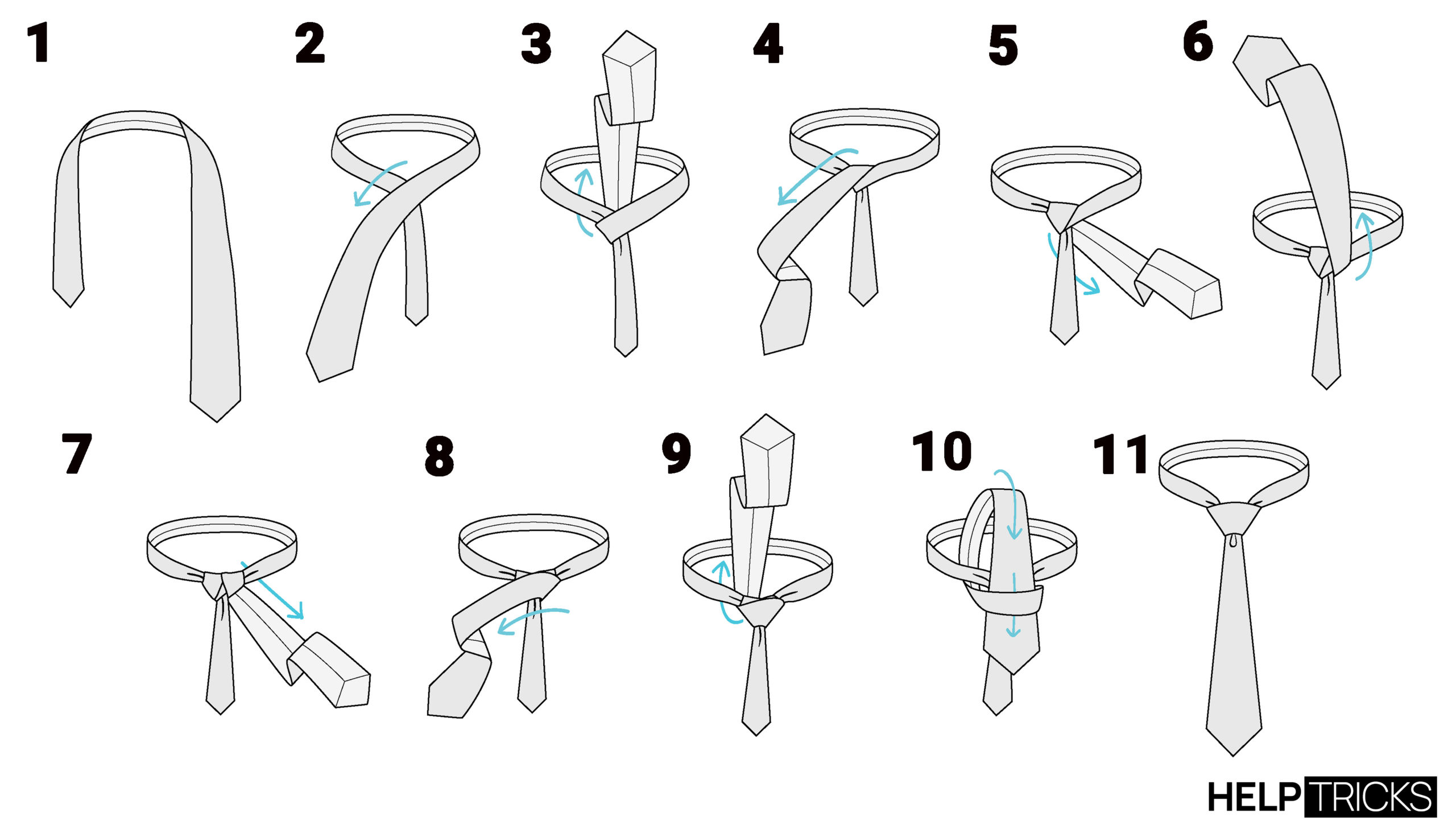
Bow Tie Knot
Wrap the bow tie around the collar with one end longer than the other. The right end should be placed over the left end in an ‘X’ shape.
Make a loop with the longer end behind the ‘X’. Keep the long end aside.
Place your index finger on the widest part of the curve on the short end and fold creating a bow shape. Keep it closer to the neck as possible.
Put the long end back from in front of the middle of the bow shape and bring it down to make a nice bow shape.
Then fold the long end to make a wing and tuck it through the loop you’ve made. Make the wings symmetrical.
And when you are done with the final adjustments, you have a fine bow tie ready to come with you!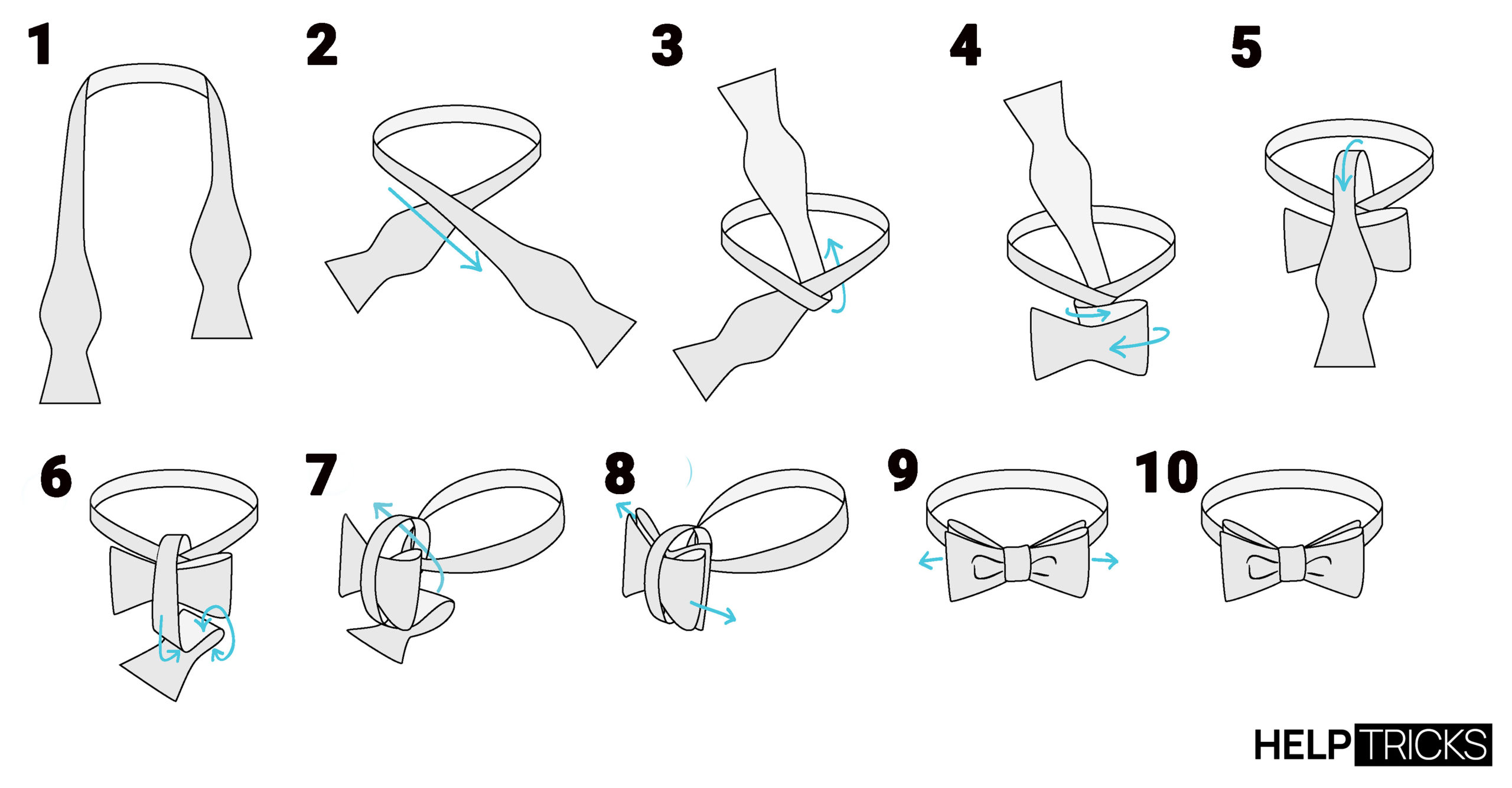
Pratt Knot
Wrap the tie around the collar, seam outwards, thick end to the left and 1-2 inches lower than the preferred finishing spot.
Cross the thick end under the narrow end to form an ‘X’ shape and pass it through the loop.
Put the thick end horizontally in front of the knot from right to left and put a finger to hold a loop.
Take the thick end from the back of the knot and put it through the loop creating the knot. You can adjust this by pulling on the narrow end as most of the other tie knots.
This is rather an easy knot.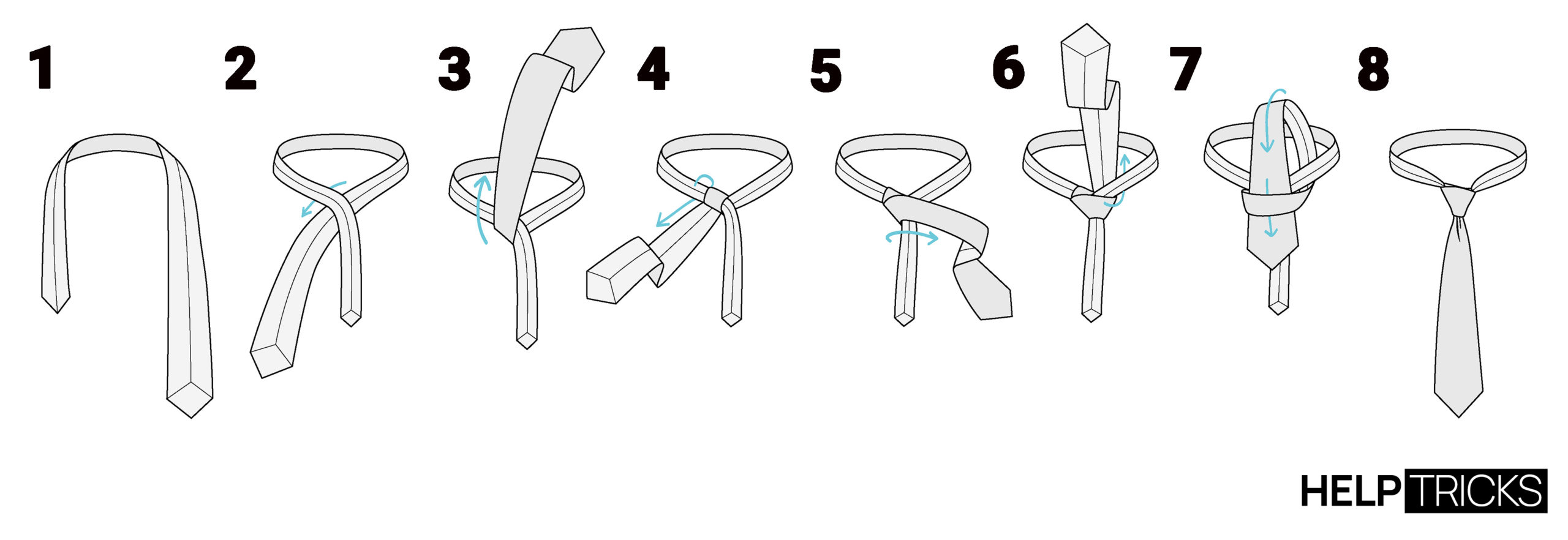
Now you know 5 of the many ways to tie a tie knot. And something is better than nothing!
]]>